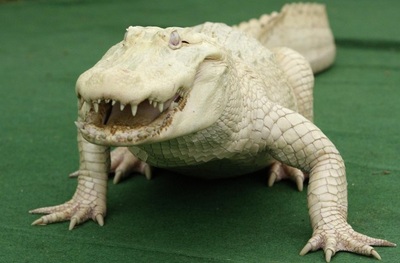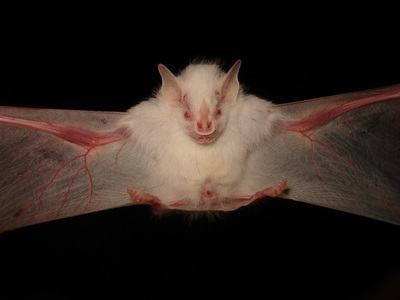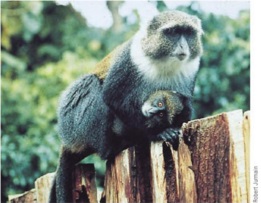
Melanin is something most everyone has, which is “a dark brown to black pigment occurring in the hair, skin, and iris of the eye in people and animals. It is responsible for tanning of skin exposed to sunlight.” Whether the person is dark skinned or light skinned, most of us have a good percentage of it in us. Now, I did say “most of us,” meaning there is a small percentage of the human race which is either lacking it in their eyes, or entirely devoid of it. That small number (1 in 20.000 people worldwide) of people have a rare condition called “albinism,” which is what this blog will be addressing. I will speak of types of albinism, the origins of it, and of other species that also express albinism.
Unlike other birth based disease (HIV, autism, etc.) which are evident from the time of birth give or take a few months and have one type, albinism has 2 types, but one of the types has 4. The one that contains 4 different types is called oculocutaneous albinism. The type 1 for this is what you would think of when you hear “albino.” Those with type 1 have milky white skin, white hair, and unlike the myth that they have red eyes, most with type 1 have blue eyes. With type 2 (most common in sub-Saharan Africans, African-Americans, and Native Americans), they still have milky white skin, but the hair “may be yellow, auburn, ginger or red, the eyes can be blue-gray or tan.” And unlike type 1 in which too much sun exposure will lead to skin cancer, type 2, when exposed to the sun, overtime may develop freckles, moles, or lentigines (sun spots). Type 3 (most common in black South Africans), do not have milky white skin. In fact, unless you knew they had albinism, you would not know. Their skin is usually reddish-brown, with ginger or reddish hair, and hazel or brown eyes. The 4th type is similar to that of type 2, but it mostly found in those of East Asian descent. The second type of albinism is known as ocular albinism, which affects the eyes, and is mostly found in males. This is caused by a mutation of a gene on the X-chromosome. Those with this type have problems with their vision, but aside from that, their skin, hair, and eye colour are generally in the colour range of those in their family. Even though albinism is very rare, there are rare disorders in it; an example is that of Hermansky-Pudlak syndrome. This rare albinism disorder is caused by a mutation in one of at least eight different genes. People with this disorder are more common in Puerto Rico. Those with this disorder have similar symptoms with those with oculocutaneous albinism, “but they may also develop lung and bowel diseases, or a bleeding disorder.” But how is one born with albinism? The answer to this question can be summarized in one word, “mutation.” All it takes is a different gene, like in autism for example, to change everything. The image below illustrates how improbable it is to be born with this disease; and unlike HIV, albinism is in no way contagious (you can refer to a previous blog in which I speak of punnett squares like the one below here: http://anthropologicalconcepts.weebly.com/blog/you-have-your-mothers-eyes)
For this disease there is no “patient zero.” But, that said “Albinism is said to be the oldest anomaly ever recorded.” Records for people with albinism can be traced to 1660 in which the term “albino” was first coined to the historian and missionary Balthazar Tellez. In his travels he first saw evidence of albinism on the West African Coast. Although that is a specific year, many years before that the Greeks had encounters with and words for those with albinism, one was leukoethrope (white), and leukoethiopians (white Ethiopians). More “recently” in United States history when slavery was still instilled, in 1869 Joseph Hones MD. published “Observations and Researches on Albinism in the Negro Race.” In this publication he claimed that those with albinism showed superiour intelligence because of their “superior” colour. He lumped those with vitiligo (image below) and albinism together, saying they “turned white in the womb.”
Unlike other birth based disease (HIV, autism, etc.) which are evident from the time of birth give or take a few months and have one type, albinism has 2 types, but one of the types has 4. The one that contains 4 different types is called oculocutaneous albinism. The type 1 for this is what you would think of when you hear “albino.” Those with type 1 have milky white skin, white hair, and unlike the myth that they have red eyes, most with type 1 have blue eyes. With type 2 (most common in sub-Saharan Africans, African-Americans, and Native Americans), they still have milky white skin, but the hair “may be yellow, auburn, ginger or red, the eyes can be blue-gray or tan.” And unlike type 1 in which too much sun exposure will lead to skin cancer, type 2, when exposed to the sun, overtime may develop freckles, moles, or lentigines (sun spots). Type 3 (most common in black South Africans), do not have milky white skin. In fact, unless you knew they had albinism, you would not know. Their skin is usually reddish-brown, with ginger or reddish hair, and hazel or brown eyes. The 4th type is similar to that of type 2, but it mostly found in those of East Asian descent. The second type of albinism is known as ocular albinism, which affects the eyes, and is mostly found in males. This is caused by a mutation of a gene on the X-chromosome. Those with this type have problems with their vision, but aside from that, their skin, hair, and eye colour are generally in the colour range of those in their family. Even though albinism is very rare, there are rare disorders in it; an example is that of Hermansky-Pudlak syndrome. This rare albinism disorder is caused by a mutation in one of at least eight different genes. People with this disorder are more common in Puerto Rico. Those with this disorder have similar symptoms with those with oculocutaneous albinism, “but they may also develop lung and bowel diseases, or a bleeding disorder.” But how is one born with albinism? The answer to this question can be summarized in one word, “mutation.” All it takes is a different gene, like in autism for example, to change everything. The image below illustrates how improbable it is to be born with this disease; and unlike HIV, albinism is in no way contagious (you can refer to a previous blog in which I speak of punnett squares like the one below here: http://anthropologicalconcepts.weebly.com/blog/you-have-your-mothers-eyes)
For this disease there is no “patient zero.” But, that said “Albinism is said to be the oldest anomaly ever recorded.” Records for people with albinism can be traced to 1660 in which the term “albino” was first coined to the historian and missionary Balthazar Tellez. In his travels he first saw evidence of albinism on the West African Coast. Although that is a specific year, many years before that the Greeks had encounters with and words for those with albinism, one was leukoethrope (white), and leukoethiopians (white Ethiopians). More “recently” in United States history when slavery was still instilled, in 1869 Joseph Hones MD. published “Observations and Researches on Albinism in the Negro Race.” In this publication he claimed that those with albinism showed superiour intelligence because of their “superior” colour. He lumped those with vitiligo (image below) and albinism together, saying they “turned white in the womb.”
This disease is not limited to humans. In our subfamily Homininae, there is another ape that has showed humans are no the only ape known to get albinism. On October 1, 1966, a lowland gorilla was captured in a region of Equatorial Guinea; a gorilla the world came to know as Snowflake (image below). He was originally named “white gorilla,” because his hair was white. Since his time of capture to the time of his death he was a celebrity at the Barcelona Zoo in Spain. Now, unlike humans, the reason for his albinism was because of inbreeding. After his death, his blood was tested and “they were able to determine that his mother and father shared 12 per cent of their DNA and concluded that this likely made them uncle and niece.” He passed away on November 24th, 2003 because of skin cancer. All that said, albinism is not limited to hominids. We all know of the white mice/rats and polar bears, but they are not albino, in the case of the polar bear it helps them blend in with the snow (this is an evolutionary advantage). But for other animals, much like with humans, their colour makes them stand out. There is a moose (image below) in Ontario, Canada who seems to blend in with the snow of their environment like the polar bear, but, as the opposite of their brethren who have very dark coats to help them camouflage with the woodlands, this moose is much more visible to wolves...and humans.
This disease seems to have plagued all manner of species; mammal, invertebrates, reptiles, birds all seem to be susceptible to albinism (images below). Let us hope that in those animals we find to have albinism are aware enough to keep out of sunlight, but, that said, I am sure they do because “The lack of pigment in the eye alters the amount of light entering the iris, leading to excessive exposure to brightness. As a result, albinos of any species, including humans, may experience great sensitivity to light.”
Please feel free to comment on what you thought of the blog, or other physical anthropological subjects you would like me to cover.
Please feel free to comment on what you thought of the blog, or other physical anthropological subjects you would like me to cover.

















 RSS Feed
RSS Feed
